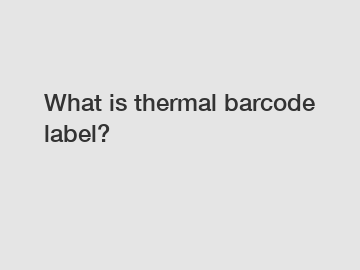What is thermal barcode label?
What is thermal barcode label? Exploring the Basics of this Essential Technology.
In this digital age where efficiency is paramount, thermal barcode labels have become indispensable tools in various industries. These labels have revolutionized inventory management, supply chain logistics, and retail operations. But what exactly is a thermal barcode label, how does it work, and why is it so crucial? Let's dive into the world of thermal barcode labels and understand their significance.
1. The Basics of Thermal Barcode Labels.

A thermal barcode label is a type of label that uses thermal printing technology to produce high-quality, durable, and reliable barcodes. These labels typically consist of a heat-sensitive material that blackens when heated, creating the black and white lines we commonly associate with barcodes. The two main types of thermal barcode labels are direct thermal and thermal transfer labels.
2. Direct Thermal Labels.
Direct thermal labels are commonly used in applications that require temporary labels such as shipping labels, receipts, or tickets. These labels are sensitive to heat and fade over time, making them ideal for short-term use. Direct thermal printers utilize heat to create images on the label, eliminating the need for ink, toner, or ribbons. Therefore, direct thermal labels offer a cost-effective solution for organizations with high-volume printing needs.
3. Thermal Transfer Labels.
Unlike direct thermal labels, thermal transfer labels rely on a two-step printing process involving a thermal transfer ribbon. The thermal transfer printer applies heat to the ribbon, transferring ink onto the label's surface. This method produces highly durable labels that can withstand harsh conditions, making them ideal for long-term labeling requirements. Thermal transfer labels are commonly used for applications such as asset tracking, product packaging, and identifying sensitive items.
4. Advantages of Thermal Barcode Labels.
Thermal barcode labels are rapidly replacing traditional paper-based labels due to their numerous advantages:
a. Durability: Thermal barcode labels are highly resistant to fading, smudging, and water damage. This durability ensures that the barcode remains readable throughout the label's lifespan, reducing errors during inventory management.
b. Cost-effectiveness: Thermal barcode labels eliminate the need for expensive ink cartridges, toners, and mass label printing. This cost-saving aspect is particularly advantageous for businesses that require large quantities of labels.
c. Efficiency and Accuracy: The use of thermal barcode labels streamlines the data collection process and minimizes human error. Scanning barcodes with handheld devices ensures accurate and real-time data capture, allowing businesses to make informed decisions swiftly.
d. Versatility: Thermal barcode labels can be customized to include additional information such as expiration dates, product descriptions, or serial numbers. This versatility enables businesses to leverage barcode labels for more complex data management tasks.
5. Applications of Thermal Barcode Labels.
The applications of thermal barcode labels are vast and varied. They are extensively used in industries such as:
a. Retail: Thermal barcode labels facilitate quick and efficient checkout processes, ensuring accurate pricing and inventory control. They are an essential tool in inventory management and help improve the overall customer experience.
b. Healthcare: In healthcare settings, thermal barcode labels enhance patient safety by accurately identifying and tracking medications, specimens, and medical equipment. This reduces the risk of medication errors and improves operational efficiency.
c. Manufacturing and Logistics: Thermal barcode labels play a pivotal role in managing supply chains, tracking inventory, and optimizing logistics operations. From labeling products to tracking shipments, thermal barcode labels are vital to ensure seamless operations and minimize errors.
6. The Future of Thermal Barcode Labels.
As technology continues to evolve, so will thermal barcode labels. Advancements such as RFID (Radio Frequency Identification) and QR codes are gradually making their mark in the market. These technologies offer enhanced data storage capabilities, improved scanning range, and more extensive compatibility with mobile devices. While traditional thermal barcode labels remain dominant, it's crucial for businesses to stay updated with emerging technologies for future-proofing their operations.
In conclusion, thermal barcode labels have revolutionized inventory management, supply chain logistics, and retail operations across various industries. Understanding the basics, advantages, applications, and the future of thermal barcode labels can help businesses harness their potential fully. These labels continue to pave the way for efficient, accurate, and cost-effective data management, propelling organizations towards success in the fast-paced digital era. So, what are you waiting for? Embrace the power of thermal barcode labels and leverage their benefits for your business's growth.
Are you interested in learning more about mobile thermal transfer printers, second hand barcode printer, hang tag barcode printer? Contact us today to secure an expert consultation!

Comments
0